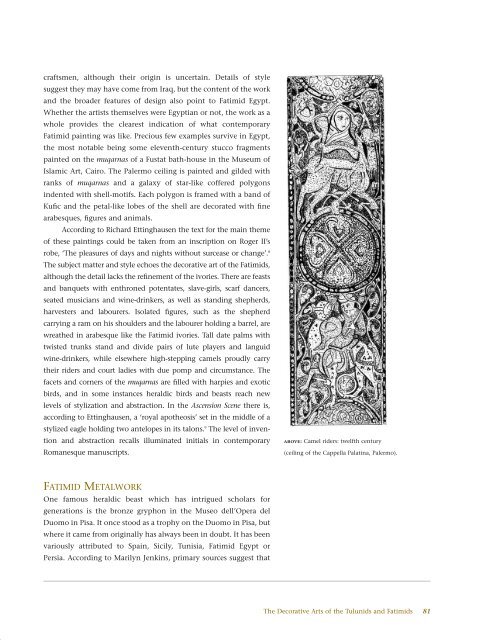The Art And Architecture of Islamic Cairo
The Art And Architecture of Islamic Cairo
The Art And Architecture of Islamic Cairo
You also want an ePaper? Increase the reach of your titles
YUMPU automatically turns print PDFs into web optimized ePapers that Google loves.
craftsmen, although their origin is uncertain. Details <strong>of</strong> style<br />
suggest they may have come from Iraq, but the content <strong>of</strong> the work<br />
and the broader features <strong>of</strong> design also point to Fatimid Egypt.<br />
Whether the artists themselves were Egyptian or not, the work as a<br />
whole provides the clearest indication <strong>of</strong> what contemporary<br />
Fatimid painting was like. Precious few examples survive in Egypt,<br />
the most notable being some eleventh-century stucco fragments<br />
painted on the muqarnas <strong>of</strong> a Fustat bath-house in the Museum <strong>of</strong><br />
<strong>Islamic</strong> <strong>Art</strong>, <strong>Cairo</strong>. <strong>The</strong> Palermo ceiling is painted and gilded with<br />
ranks <strong>of</strong> muqarnas and a galaxy <strong>of</strong> star-like c<strong>of</strong>fered polygons<br />
indented with shell-motifs. Each polygon is framed with a band <strong>of</strong><br />
Kufic and the petal-like lobes <strong>of</strong> the shell are decorated with fine<br />
arabesques, figures and animals.<br />
According to Richard Ettinghausen the text for the main theme<br />
<strong>of</strong> these paintings could be taken from an inscription on Roger II’s<br />
robe, ‘<strong>The</strong> pleasures <strong>of</strong> days and nights without surcease or change’. 8<br />
<strong>The</strong> subject matter and style echoes the decorative art <strong>of</strong> the Fatimids,<br />
although the detail lacks the refinement <strong>of</strong> the ivories. <strong>The</strong>re are feasts<br />
and banquets with enthroned potentates, slave-girls, scarf dancers,<br />
seated musicians and wine-drinkers, as well as standing shepherds,<br />
harvesters and labourers. Isolated figures, such as the shepherd<br />
carrying a ram on his shoulders and the labourer holding a barrel, are<br />
wreathed in arabesque like the Fatimid ivories. Tall date palms with<br />
twisted trunks stand and divide pairs <strong>of</strong> lute players and languid<br />
wine-drinkers, while elsewhere high-stepping camels proudly carry<br />
their riders and court ladies with due pomp and circumstance. <strong>The</strong><br />
facets and corners <strong>of</strong> the muqarnas are filled with harpies and exotic<br />
birds, and in some instances heraldic birds and beasts reach new<br />
levels <strong>of</strong> stylization and abstraction. In the Ascension Scene there is,<br />
according to Ettinghausen, a ‘royal apotheosis’ set in the middle <strong>of</strong> a<br />
stylized eagle holding two antelopes in its talons. 9 <strong>The</strong> level <strong>of</strong> invention<br />
and abstraction recalls illuminated initials in contemporary<br />
Romanesque manuscripts.<br />
FATIMID METALWORK<br />
One famous heraldic beast which has intrigued scholars for<br />
generations is the bronze gryphon in the Museo dell’Opera del<br />
Duomo in Pisa. It once stood as a trophy on the Duomo in Pisa, but<br />
where it came from originally has always been in doubt. It has been<br />
variously attributed to Spain, Sicily, Tunisia, Fatimid Egypt or<br />
Persia. According to Marilyn Jenkins, primary sources suggest that<br />
above: Camel riders: twelfth century<br />
(ceiling <strong>of</strong> the Cappella Palatina, Palermo).<br />
<strong>The</strong> Decorative <strong>Art</strong>s <strong>of</strong> the Tulunids and Fatimids 81











